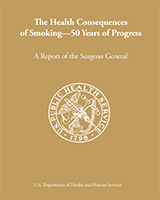NCBI Bookshelf. A service of the National Library of Medicine, National Institutes of Health.
National Center for Chronic Disease Prevention and Health Promotion (US) Office on Smoking and Health. The Health Consequences of Smoking—50 Years of Progress: A Report of the Surgeon General. Atlanta (GA): Centers for Disease Control and Prevention (US); 2014.

The Health Consequences of Smoking—50 Years of Progress: A Report of the Surgeon General.
Show detailsFifty years have passed since publication of the landmark report of the Surgeon General's Advisory Committee on smoking and health. This report highlights both the dramatic progress our nation has made reducing tobacco use and the continuing burden of disease and death caused by smoking.
As a physician, when I think about smoking, I recall the patients I have cared for. The man who had a leg amputated. The woman who had to gasp for every single breath that she took. The man with heart disease who hoped to see his son graduate, but didn't live long enough to do so. That's the reality of smoking that health care providers see every day.
The prevalence of current cigarette smoking among adults has declined from 42% in 1965 to 18% in 2012. However, more than 42 million Americans still smoke. Tobacco has killed more than 20 million people prematurely since the first Surgeon General's report in 1964. The findings in this report show that the decline in the prevalence of smoking has slowed in recent years and that burden of smoking-attributable mortality is expected to remain at high and unacceptable levels for decades to come unless urgent action is taken.
Recent surveys monitoring trends in tobacco use indicate that more people are using multiple tobacco products, particularly youth and young adults. The percentage of U.S. middle and high school students who use electronic, or e-cigarettes, more than doubled between 2011 and 2012. We need to monitor patterns of use of an increasingly wide array of tobacco products across all of the diverse segments of our society, particularly because the tobacco industry continues to introduce and market new products that establish and maintain nicotine addiction.
Tobacco control efforts need to not only address the general population, but also to focus on populations with a higher prevalence of tobacco use and lower rates of quitting. These populations include people from some racial/ethnic minority groups, people with mental illness, lower educational levels and socioeconomic status, and certain regions of the country. We now have proven interventions and policies to reduce tobacco initiation and use among youth and adults.
With intense use of proven interventions, we can save lives and reduce health care costs. In 2012, the Centers for Disease Control and Prevention (CDC) launched the first-ever paid national tobacco education campaign — Tips From Former Smokers (Tips) — to raise awareness of the harms to health caused by smoking, encourage smokers to quit, and encourage nonsmokers to protect themselves and their families from exposure to secondhand smoke. It pulled back the curtain in a way that numbers alone cannot, and showed the tobacco-caused tragedies that we as health care professionals see and are saddened by every day. As a result of this campaign, an estimated 1.6 million smokers made an attempt to quit and, based on a conservative estimate, at least 100,000 smokers quit for good. Additionally, millions of nonsmokers talked with friends and family about the dangers of smoking and referred smokers to quit services. In 2013, CDC launched a new round of advertisements that helped even more people quit smoking by highlighting the toll that smoking-related illnesses take on smokers and their loved ones.
CDC has also established reducing tobacco use as one of its “Winnable Battles.” These are public health priorities with large-scale impact on health that have proven effective strategies to address them. CDC believes that with additional effort and support for evidence-based, cost-effective policy and program strategies to reduce tobacco use, we can reduce smoking substantially, prevent millions of people from being killed by tobacco, and protect future generations from smoking.
While we have made tremendous progress over the past 50 years, sustained and comprehensive efforts are needed to prevent more people from having to suffer the pain, disability, disfigurement, and death that smoking causes. Most Americans who have ever smoked have already quit, and most smokers who still smoke want to quit. If we continue to implement tobacco prevention and cessation strategies that have proven effective in reducing tobacco use, people throughout our country will live longer, healthier, more productive lives.
- Thomas R. Frieden, M.D., M.P.H.DirectorCenters for Disease Control and Prevention
- Foreword - The Health Consequences of Smoking—50 Years of ProgressForeword - The Health Consequences of Smoking—50 Years of Progress
Your browsing activity is empty.
Activity recording is turned off.
See more...